SHOPLINE vs Shopify are two standout eCommerce options. Both have loyal followings and promise an easy path to online sales success, but their features and functionalities differ significantly. Yes, they can get your store up and running, but which one fits your goals better?
This article will answer your question by delving into the following points:
- Overview of SHOPLINE vs Shopify
- 9 key comparisons between Shopify vs SHOPLINE
- Which one should you choose
Without further ado, let's get started!
An Overview of SHOPLINE vs Shopify
1. About SHOPLINE

As one of the leading eCommerce platforms in Asia, SHOPLINE helps businesses of all sizes to set up and manage online stores. It also provides features to integrate with popular shipping carriers, social media platforms, and payment gateways.
As of my writing, over 96,000 websites (according to BuiltWith) are using its platform. It's particularly popular in the United States, China, Taiwan, Spain, Hong Kong, Malaysia, the United Kingdom, and Singapore.
2. About Shopify

Like SHOPLINE, Shopify is a major player in the world of eCommerce. Simply put, it provides an eCommerce platform that businesses can access through a subscription. Merchants can create and manage their online stores here without the hassle of maintaining the servers or software.
By 2024, Shopify boasts a massive user base with over 7.7 million websites currently using their platform (reports from BuiltWith). It enjoys widespread popularity in the U.S. (especially North America), the United Kingdom, Australia, Germany, Brazil, Canada, France, India, the Netherlands, and Italy.
SHOPLINE vs Shopify 2024: 9 Key Comparisons
An eCommerce platform can either make or break your long-term business. Shopify is undoubtedly the global leader, but SHOPLINE also holds its ground well in this battle!
To break down their differences, I have built a charming Etsy-inspired hat store on Shopify and a fashion clothing store on SHOPLINE. Here's what I have learned so far regarding the SHOPLINE vs Shopify comparison:
Features | Shopify | SHOPLINE | Winner |
Pricing Plans | Cheaper starting plans but limited staff accounts | More affordable higher-tier plans, more staff accounts | A tie |
User Experience | More affordable higher-tier plans, more staff accounts | Fewer buttons, faster loading, simple layout | SHOPLINE |
Themes & Design | Vast collection, extensive filtering options | Limited selection, fewer filtering options | Shopify |
Apps & Plugins | 8000+ apps, diverse and powerful | 120+ apps, well-tested but limited | Shopify |
POS | Seamless integration, versatile hardware support | Real-time sync, automated loyalty campaigns | A tie |
eCommerce Features | Wide range of dropshipping apps, 100 payment providers | Limited dropshipping apps, < 25 payment partners | Shopify |
SEO & Marketing Features | Strong email marketing, vast SEO app selection | Comprehensive social media marketing tools | A tie |
Reports & Analytics | 60+ pre-built reports, industry average comparisons | 80+ customizable reports, flexible export options | SHOPLINE |
Customer Support | 24/7 support, live chat available | Primarily email support, inconsistent response time | Shopify |
1. Pricing Plans (A Tie)
Both platforms offer 4 pricing plans to cater to varying needs and business sizes.
Shopify provides a far better starting point for small startups (only $19 a month). On the other hand, SHOPLINE is more affordable as you upgrade to higher plans (its premium package is $30 cheaper than Shopify's Advanced). Plus, you receive 100 staff accounts with SHOPLINE Premium, while Shopify only gives you 15 extra accounts!
The differences in features among the 4 Shopify plans are quite clear-cut. However, I cannot say the same about SHOPLINE, as its packages introduce quite similar benefits (besides the number of staff accounts).
Shopify Pricing Plan
At the moment, Shopify offers 4 pricing plans:
- Basic: $19 a month
- Shopify: $49 a month
- Advanced: $299 a month
- Plus: Starting at $2300 a month

SHOPLINE Pricing Plan
SHOPLINE also has 4 pricing plans:
- Starter: $29 a month
- Essential: $79 a month
- Premium: $269 a month
- Enterprise: Varies depending on your needs

The Verdict
This SHOPLINE vs Shopify round is a tie. Shopify has cheaper starting plans but a limited number of staff accounts. SHOPLINE offers more affordable higher-tier packages with far more staff accounts, but you can hardly see the differences in features among its 4 plans.
2. User Experience (SHOPLINE wins)
Both platforms are easy to use, even for beginners. There are clear steps and guidelines to follow, and the function of each button is well-explained (for example, to add a product, I simply need to click “Add product” – that's all!!). Everything is very straightforward.
Shopify User Experience
Shopify is among the easiest-to-use eCommerce platforms, so you will not have much trouble getting started here.
There's only one small problem that takes a few points away: You must answer many “getting-started” questions before setting up the new store. Plus, since the website has many buttons and illustrations, its loading speed is not always the best (though still good most of the time).

SHOPLINE User Experience
How about SHOPLINE? I can say its user experience is on par with Shopify. The screen features very few buttons, so it doesn't feel cluttered and loads extremely fast!
Furthermore, the getting-started process is broken down into just four steps, each requiring you to fill in simple blanks. To me, that's a huge improvement over Shopify and its multiple questions! The font used throughout the interface is large and easy to read, too, with ample spacing between elements to ensure the layout doesn't feel overwhelming.
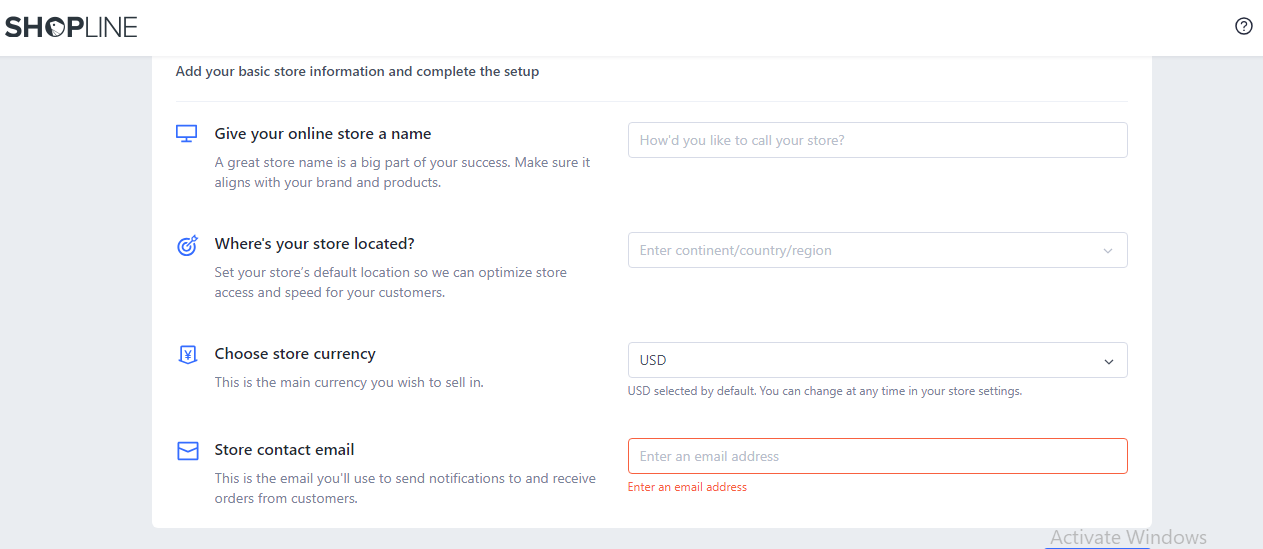
The Verdict
SHOPLINE wins the round with fewer buttons, great layout and spacing, and a much faster loading speed. It's a wonderful choice for anyone prioritizing simple and efficient usage in their online store management.
3. Themes & Design (Shopify wins)
Both SHOPLINE vs Shopify offer stunning themes tailored to different selling needs and industries. They are easily customizable so that you can adjust images, colors, heading positions, and more! Plus, if you have some decent coding experience, why not refine the themes further to fit your brand?
Shopify Themes
Shopify offers a vast collection of 13 free themes and 198 paid themes (totaling 210), complete with extensive filtering options!
For example, I often filter the themes by price (free or paid), type of industry, and even specific desired features like age verification, back-to-back buttons, and color swatches. Anyone can find a beautiful and appropriate store theme with almost no effort!

SHOPLINE Themes
Although SHOPLINE provides visually appealing themes, its selection is somewhat limited in number and filtering options. The themes are broadly categorized into several industry topics (Electronics, Beauty & Health, etc.). Therefore, finding the best theme for your store can be slightly challenging if your business doesn't fit neatly into these categories.
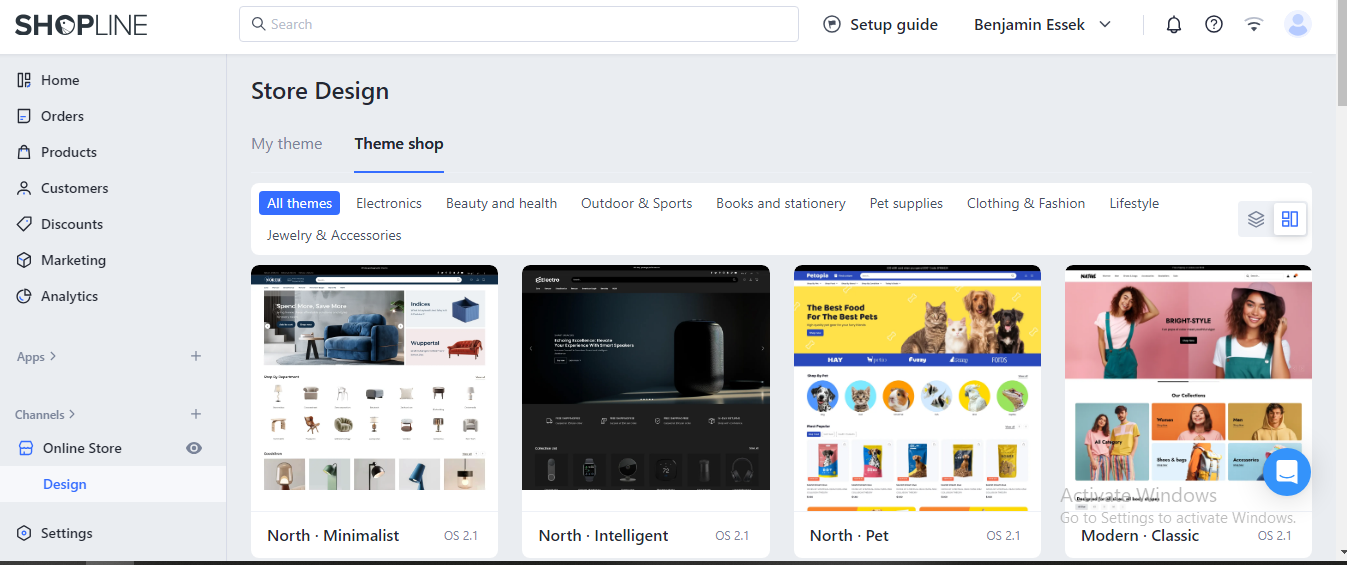
The Verdict
Shopify outperforms SHOPLINE in both the number and categorization of themes. Thanks to its diverse yet detailed filtering options, you can quickly create a professional-looking store tailored to your needs and preferences in minutes.
4. Apps & Plugins (Shopify wins)
Shopify only edged out in the previous SHOPLINE vs Shopify rounds, but this time it won big. The sheer volume and variety of apps available on Shopify make it an incredibly powerful platform for any eCommerce need.
Shopify Apps
Shopify boasts 8000+ apps, one of the largest selections in the eCommerce world. Since each app undergoes rigorous testing, you know there are quality tools for varying preferences: selling products, design tweaks, store management, and more. Better yet, you can even peek at what apps similar stores to yours have been using, which is extremely handy if you're just starting out.
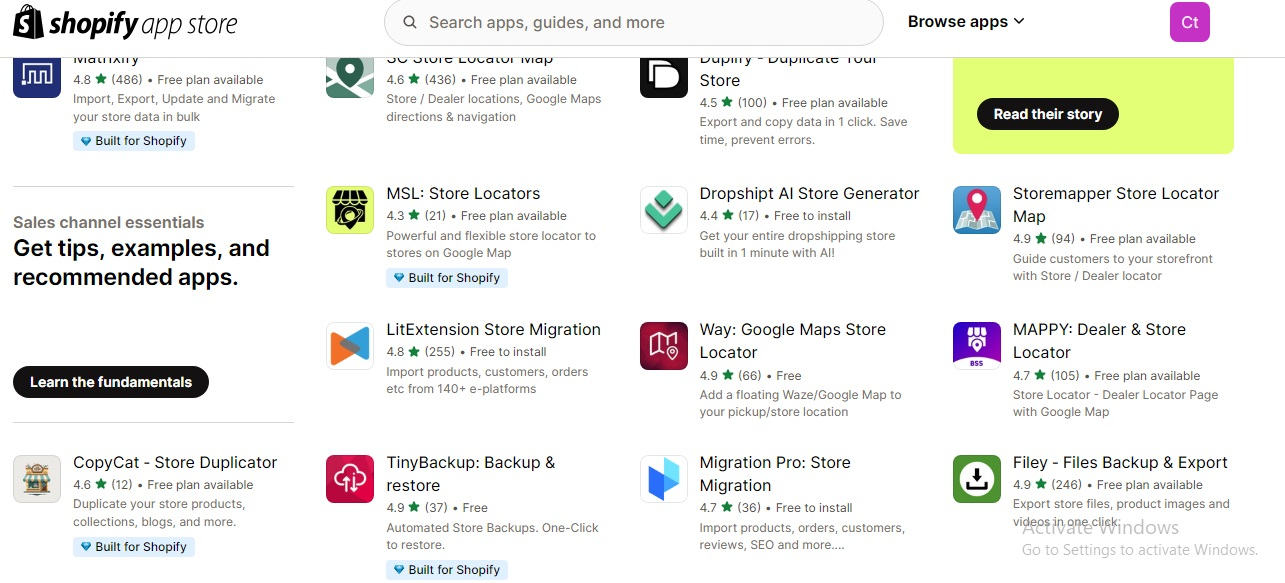
With over 8000+ apps on the Shopify App Store, you can easily find one that meets your needs. For example, if you're aiming to boost sales, consider BOGOS to create your promotional offers.
SHOPLINE Apps
Conversely, SHOPLINE has a more modest selection with around 120+ apps.
While it's a small number compared to Shopify, each app is well-tested and highly rated by users. This smaller selection is actually a plus for beginners since it's less overwhelming and much easier to navigate. I used to be a beginner myself, so I have been there!
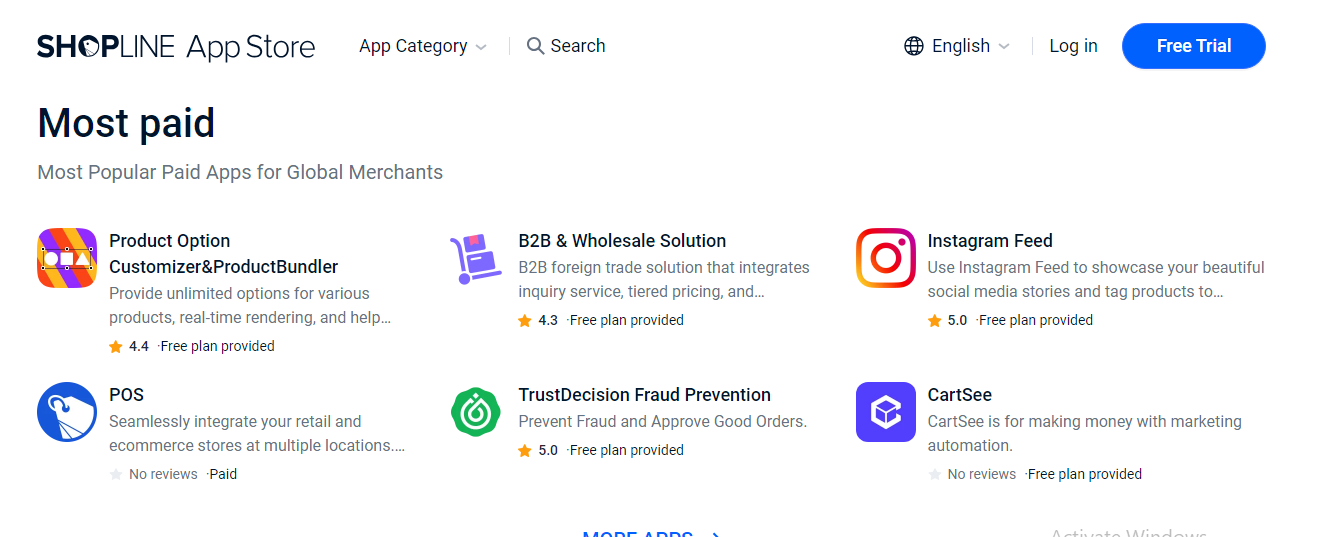
The Verdict
Shopify wins hands down with its vast array of apps catering to diverse needs, offering over 8000 options compared to SHOPLINE's 120+. On the other hand, if you're a fresh beginner, SHOPLINE's more curated selection might feel more manageable.
Seamlessly Migrate Your Store to Shopify
Our team of experts can safely transfer your business data, products, customers, and orders to unlock more growth on Shopify. Let us provide a customized migration for you!
5. POS (A tie)
It's evident that both SHOPLINE and Shopify POS make it easy to sell products across different sales channels. They offer incredible features to reduce downtime and keep stock levels accurate.
Shopify POS
Shopify POS is available for both Android and iOS devices, so managing your sales on the go is extremely easy!
I also like that it can sync smoothly with my Shopify account to keep track of orders across all sales channels (whether online shops or physical stores). Feel free to manage orders right from the mobile app if you want to.
Another great highlight is its smooth connection with diverse hardware. You can even buy the hardware straight from Shopify stores (unless your country is not on the platform's support list!) Once all the hardware and store setups are completed, you can start selling your products using Shopify POS immediately.
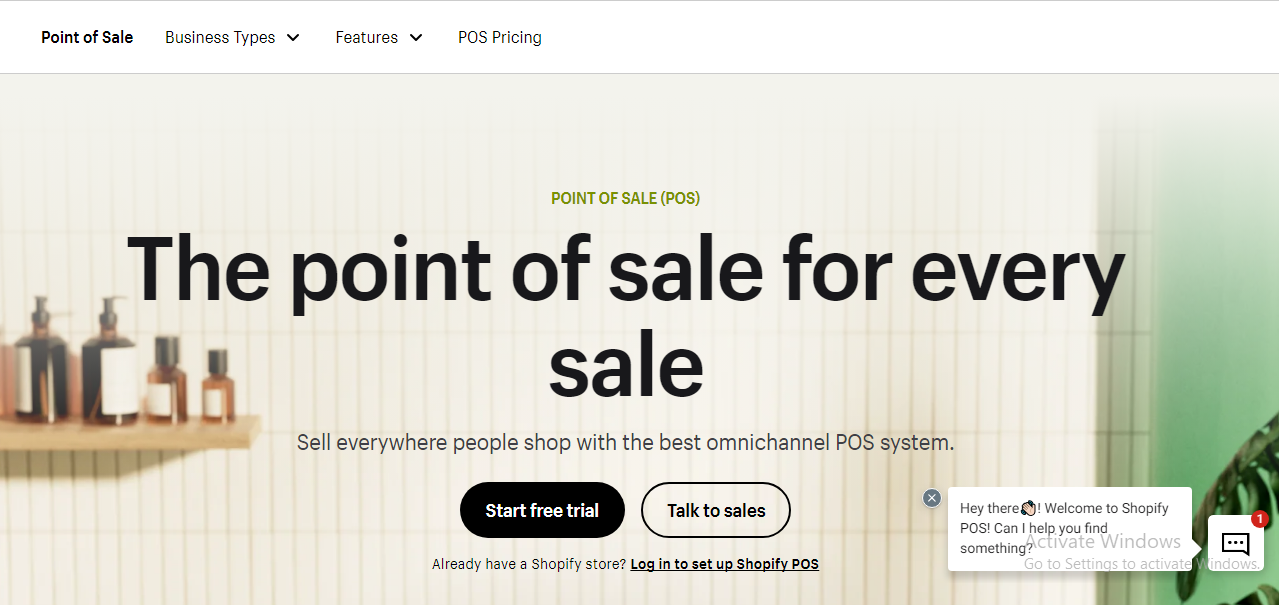
SHOPLINE POS
Like Shopify POS, SHOPLINE POS (both IOS and Android) makes it easy to sell your products everywhere, from in-store to online and even on social media platforms! It keeps your stock in sync across all sales channels in real time, bolstered by other support features like smart reordering, inventory alerts, and options to transfer stock between locations.
This app also supports automated loyalty campaigns; many businesses have relied on SHOPLINE POS to create detailed customer profiles and reward their best customers. Real-time analytics give you a glimpse into sales performance, top products (and even best-performing employees). From here, you can make smart decisions to grow your business.

The Verdict
We have another tie between Shopify vs SHOPLINE here. They offer quick, seamless integration across in-store, online, and social media sales. You can manage and expand your business from anywhere!
6. eCommerce Features (Shopify wins)
Shopify clearly takes the lead here. As one of the biggest eCommerce platforms, it partners with a wide range of dropshipping apps and payment providers. SHOPLINE, while also a solid choice, is still growing and doesn't have as many partnerships as Shopify.
Products Management
SHOPLINE vs Shopify are quite similar in this regard. They both rely on SKUs (stock-keeping units) for their product management systems. These SKUs are unique codes for each product, including price, color, product descriptions, etc. You can turn them into barcodes for easy scanning!
Better yet, since these platforms have no universal SKU standard, I often create a personalized system that works best for my store. With SHOPLINE, each SKU is displayed right above the product name in the Product Details panel, so the tracking process is almost 100% hassle-free.
Dropshipping
Shopify has the upper hand here due to its wide selection of supported apps, including the well-known DSers-AliExpress. This gives merchants worldwide access to high-quality services and many diverse options.

On the other hand, SHOPLINE works with far fewer dropshipping apps, and some of them are not as popular as Shopify's options like DSers. The platform needs to catch up in this regard in order to compete with Shopify.

Payment Gateways
Shopify shines with over 100 partners and payment providers. To find one that works for my country (say, America), I only have to type America in the search box!
Another highlight is Shopify Payments, a built-in payment gateway for businesses using the Shopify platform to sell online. It lets you accept customer payments without needing a separate merchant account! There's no need to set up a third-party payment processor or enter extra credentials. Even better, you won't be charged extra for using their built-in payment methods (like Shop Pay) or for manual options like cash on delivery.
On the contrary, SHOPLINE works with fewer than 25 partners – much more limited than Shopify. Fortunately, it still supports well-known names like PayPal and OceanPayment! Let's say PayPal is your go-to for payments; in that case, both Shopify and SHOPLINE will work just fine for you.
The Verdict
Shopify offers many more options for dropshipping and payment providers, which helps you expand your business to more regions. SHOPLINE, on the other hand, is still rather limited in these areas.
7. SEO & Marketing Features (A tie)
To choose the right eCommerce platform, you should consider the marketing and SEO tools it offers. Both SHOPLINE vs Shopify are strong contenders, though in different ways.
Shopify Marketing Features
Shopify's strongest marketing features are customizable forms and email templates. You can easily align them with your branding and additional editing features!
Furthermore, it's quite easy to set up automated email sequences at various touchpoints, including abandoned carts, welcome emails, and post-purchase follow-ups. As a result, you can stay connected with your customers at key stages in their buying journey without having to send each email manually.
Furthermore, Shopify does offer some built-in advantages for SEO, such as generating sitemaps or preventing duplicate content issues. Many apps on the marketplace also offer Shopify-centric tools for image/content optimization, broken link checking, keyword research, and more!
On the other hand, I have to say that Shopify's marketing tools do not cater much to social media platforms (like SHOPLINE's do).
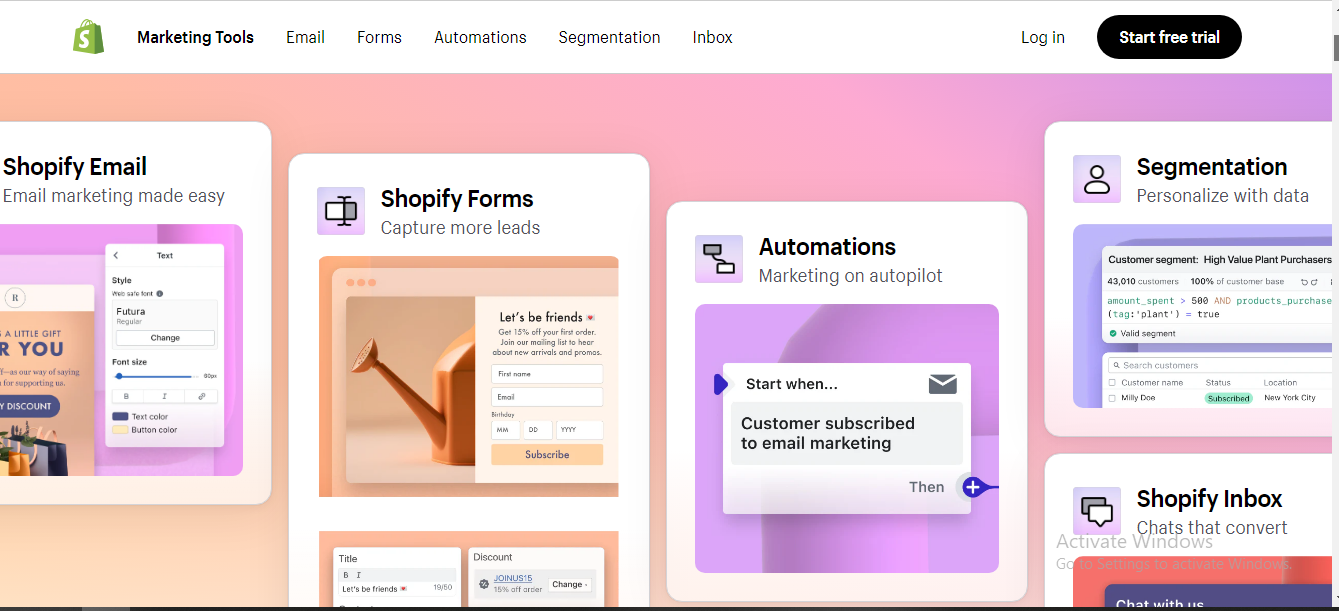
SHOPLINE Marketing Features
Regarding marketing features, SHOPLINE takes a much more inclusive approach than Shopify! Shopify mostly excels in email marketing, but SHOPLINE caters to your target audience across various platforms. It offers specialized, separate tools and services for:
- Amazon
- Tiktok
Its SEO functionalities also go beyond the basics. The platform notably includes a detailed on-page optimization guide and structured data markup for richer search results.
Still, there's one considerable downside. Since SHOPLINE has a smaller user base than Shopify, it translates to fewer third-party SEO apps on the marketplace.
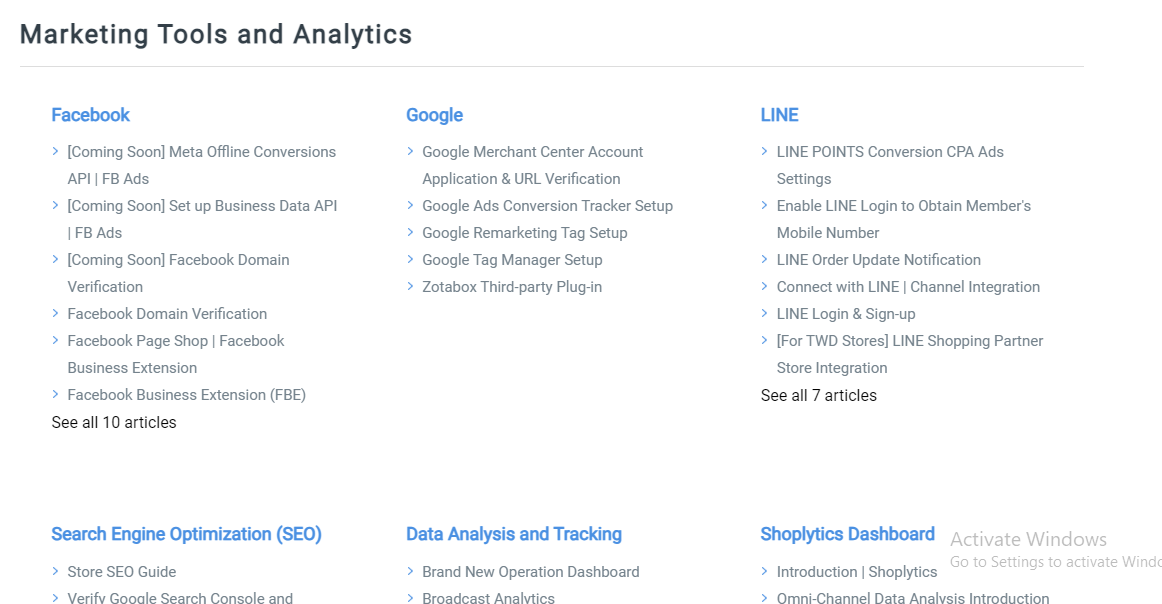
The Verdict
It's a tie. Do you prioritize user-friendly email marketing and a vast app selection for SEO? Then, Shopify might be the right fit. However, if you value a comprehensive marketing suite for social media, SHOPLINE is the stronger option.
8. Reports & Analytics (SHOPLINE wins)
Data reports are the lifeblood of any eCommerce business. Both SHOPLINE vs Shopify offer valuable tools, but in my opinion, SHOPLINE totally takes the lead.
Shopify Reporting Tools
Shopify offers a suite of over 60 pre-built reports designed specifically for eCommerce businesses. With its features, you can:
- Compare your store's performance metrics against industry averages to identify areas for improvement.
- Analyze data on returning customers and those at risk of churn
- Compare metrics like customer acquisition costs, conversions, and sales to determine the effectiveness of your marketing
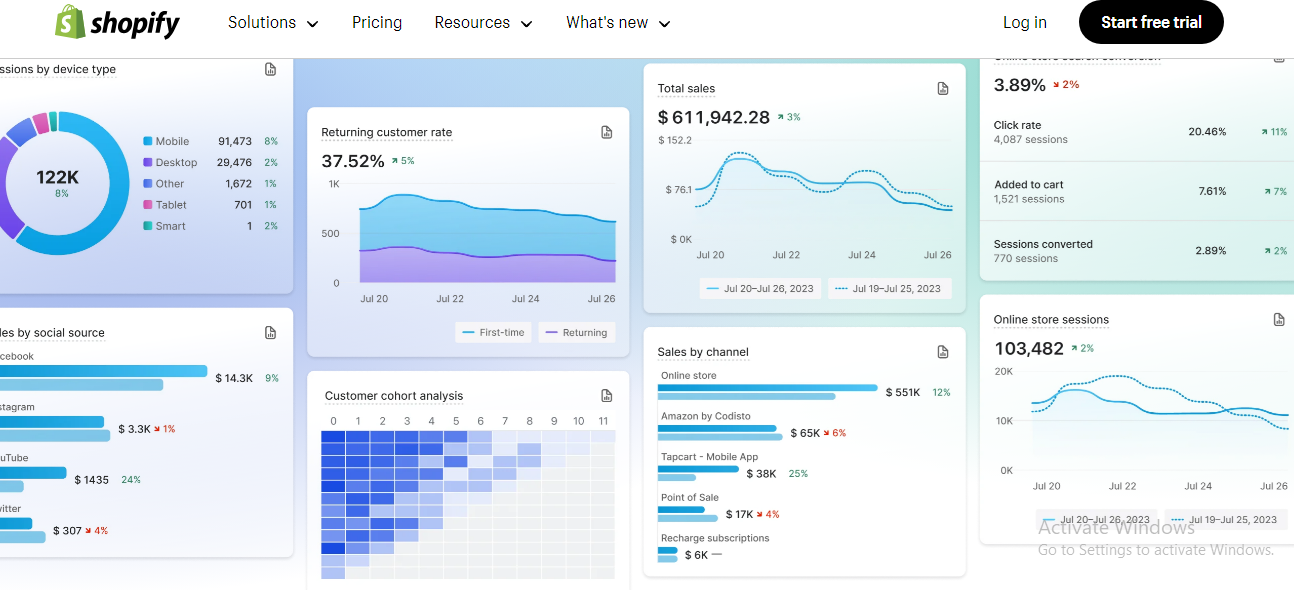
SHOPLINE Reporting Tools
On the flip side, SHOPLINE has a powerful reporting suite with over 80 customizable reports (more than Shopify) – all accessible through an easy-to-use search system!
These reports display your store data in charts and tables, which you may sort and filter (or even personalize) to fit your needs. Each report shows up to 1,000 rows, but you can always export the full dataset for deeper analysis in other programs.

The Verdict
Both platforms allow you to dig deeper into each important performance metric. Still, if you are looking for a wider range of pre-built reports and flexible export options, SHOPLINE is the one.
9. Customer Support (Shopify wins)
Almost every eCommerce platform offers customer support, and SHOPLINE vs Shopify are no exceptions! Nevertheless, their approaches differ.
Shopify Customer Support
Shopify offers round-the-clock customer support across all their plans. Simply put, you can get help with any issue, regardless of how much you pay for the service!
That's great news for new store owners who might have many questions as they start. Plus, if you want quick answers, a 24/7 live chat box on the website will let you immediately connect with a support agent.
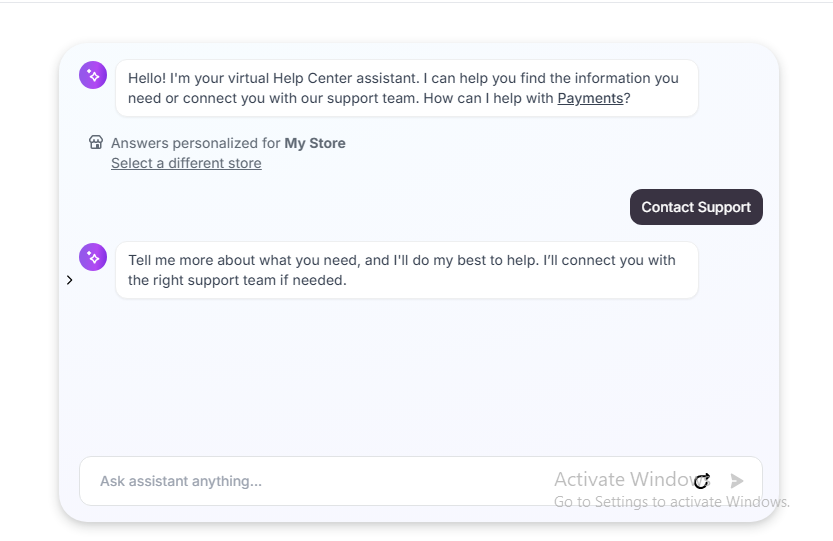
SHOPLINE Customer Support
SHOPLINE's primary channel is email support, and their response times might vary depending on their workload. Interestingly, they offer a live chat option within their point-of-sale app, but I don't see such functionality on their website. This is quite a limitation for users who primarily manage their store online.
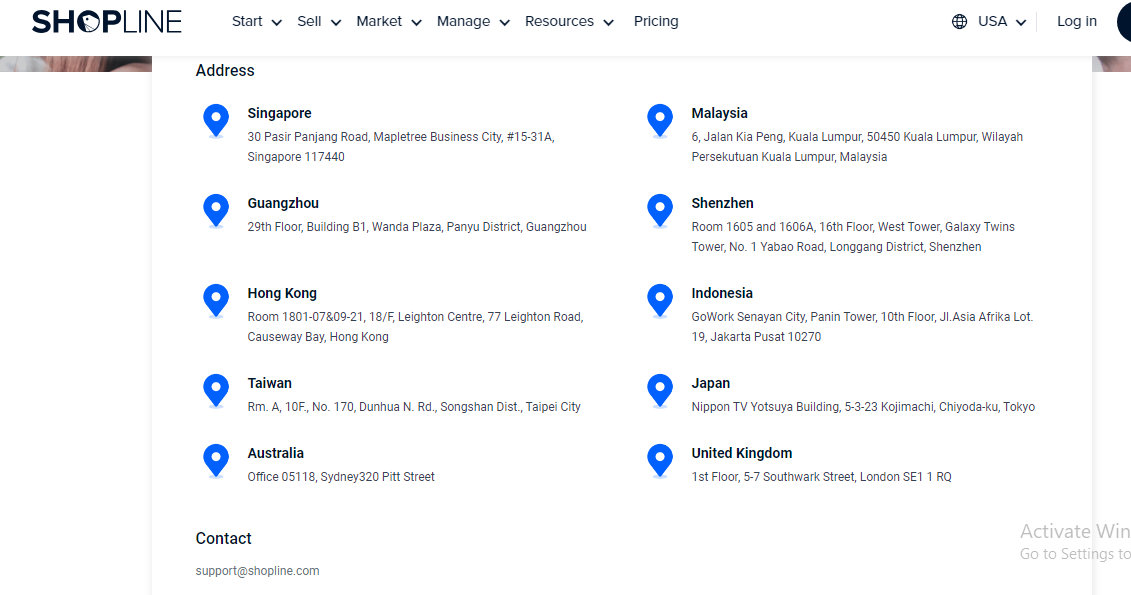
The Verdict
Shopify's robust and readily available support system makes it the frontrunner for businesses requiring immediate help. SHOPLINE, on the other hand, relies more on email and lacks a guaranteed response timeframe.
SHOPLINE vs Shopify 2024: Which One Should You Choose?
After comparing Shopify vs SHOPLINE across 9 key areas, I can say Shopify comes out on top with 5 big wins! It offers a wider range of apps, excellent store customization, and impressive customer support to meet varying eCommerce demands.
Yet, SHOPLINE also has incredible strengths, particularly its intuitive interface and numerous targeted reporting and marketing features! Let's now explore when Shopify or SHOPLINE would be the best choice based on your business needs.
1. When to choose Shopify?
- New businesses: Shopify's lower starting plans and 24/7 support are perfect for startups!
- Customization: Shopify's wide range of themes and detailed filtering options are unbeatable if you want a highly customized and professional online store.
- Brand expansion: The platform's 8,000+ apps cover a wide array of eCommerce needs. (not to mention the superior dropshipping options and a large number of payment providers!)
2. When to choose SHOPLINE?
- Growing teams: Are you a small to medium business planning to expand your team? SHOPLINE is a great fit. Its higher-tier plans are more affordable and offer more staff accounts than Shopify.
- Simple and fast: SHOPLINE’s user interface is straightforward with impressive loading speed – a great choice for those who value simplicity and speed.
- Social media marketing: If your business thrives on social media, SHOPLINE’s tools for platforms like Facebook, Google, Amazon, TikTok, and WhatsApp are excellent.
Shopify vs SHOPLINE: Our Testing Method
After building my stores on both platforms, I closely analyzed their performances for the next 4 months using a structured methodology. I assigned varying weights to 9 key criteria based on their importance, detailed as follows:
1. eCommerce Features (20%)
Core eCommerce functionalities (such as product management, dropshipping options, and payment gateway integrations) are the backbone of an online store! I weighed this criterion at 20% since these features directly impact a store's ability to meet customer demands.
2. SEO & Marketing Features (20%)
Your store can hardly succeed if you fail to drive traffic and build a name for yourself. That's why I want to evaluate key tools like email marketing, social media integration, SEO, and marketing automation.
3. Pricing Plans (15%)
Both startups and established businesses must consider cost-effectiveness (or their bottom line)! I do not just identify the platform with the lower price but also analyze the value provided at each price point. (e.g., scalability and the number of features).
4. User Experience (15%)
A platform that is easy to navigate can save time and reduce frustration! My team analyzes the interface's intuitiveness, instruction clarity, and ease of transition from setup to daily operations.
5. POS (Point of Sale) (10%)
Most businesses have more than one sales channel; hence, a robust POS system should never be crossed off the list! For this criterion, I assessed:
- The compatibility of the POS systems with various hardware
- Ease of setup
- Functionality for managing in-store and online sales
- Real-time synchronization of inventory and sales data.
6. Apps & Plugins (10%)
A rich ecosystem of apps and plugins allows businesses to tailor their stores to specific needs.
I evaluated the two platforms based on the number of available apps (+ their reliability) and whether you can easily integrate them into your store. User reviews for these apps are also taken into account!
7. Themes & Design (5%)
The visual appeal of an online store can significantly impact customer perception and conversion rates. I break down the number of themes each platform offers, filtering options (if any), and whether personalizing them is difficult for you.
8. Reports & Analytics (2.5%)
This feature paves the way for smart, informed business decisions! I evaluated the two platforms based on:
- The variety and depth of their reporting tools
- Ability to customize reports
- Ease of exporting data for further analysis
9. Customer Support (2.5%)
With timely and effective support, businesses (especially start-ups) can navigate challenges and reduce downtime more effectively. When assessing them, I always keep in mind:
- The availability of support channels (are they live chat, email, or phone?)
- The staff's responsiveness
- Level of helpfulness
- (Optional) Extra resources like tutorials and forums.
SHOPLINE vs Shopify 2024: FAQs
Which is better, Shopify or Shopline?
The answer boils down to your needs.
Shopify excels in global reach (thanks to its large market share) and offers an enormous app store for almost any need. On the other hand, SHOPLINE stands out for its strong marketing tools tailored for the region and simple, beginner-friendly interface.
Is SHOPLINE a good platform?
Yes. It does have some downsides, but overall, SHOPLINE is a dominant player in Asia.
The platform boasts a simple and intuitive interface, which is ideal for beginners who might find Shopify a little steeper to learn! Its key eCommerce and marketing features also receive positive feedback.
Is SHOPLINE payment safe?
Yes. SHOPLINE complies with the Payment Card Industry Data Security Standard (PCI DSS) at Level 1, the highest level of security available. They strictly adhere to rigorous data security protocols to protect your financial information.
Final Words
Shopify stands out as the ultimate winner in this SHOPLINE vs Shopify comparison. It's easy to see why it's one of the biggest eCommerce platforms in the world! That said, SHOPLINE deserves some credit for putting up a strong fight and scoring 2 wins and 2 ties — which is quite impressive.
If you're considering moving your store to either Shopify or SHOPLINE, our LitExtension Expert team can help. With decades of experience and over 300,000 successful migrations, we can ensure a smooth, hassle-free transition for your business.
For more insights and updates, check out LitExtension blog and eCommerce Community.

